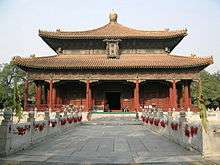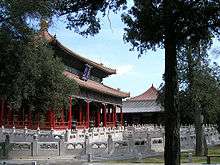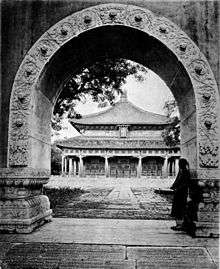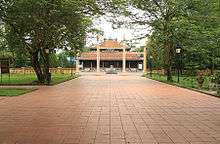Guozijian
| Guozijian | |||||||||
| Pre-Northern Qi | |||||||||
|---|---|---|---|---|---|---|---|---|---|
| Traditional Chinese | 國子學 | ||||||||
| Simplified Chinese | 国子学 | ||||||||
| |||||||||
| Northern Qi, Sui, early Tang | |||||||||
| Traditional Chinese | 國子寺 | ||||||||
| Simplified Chinese | 国子寺 | ||||||||
| |||||||||
| Post-Sui | |||||||||
| Traditional Chinese | 國子監 | ||||||||
| Simplified Chinese | 国子监 | ||||||||
| |||||||||
| Vietnamese name | |||||||||
| Vietnamese | Quốc Tử Giám | ||||||||
| Korean name | |||||||||
| Hangul | 국자감 | ||||||||
| Hanja | 國子監 | ||||||||
| |||||||||


The Guozijian,[1] sometimes translated as the Imperial College or Imperial Academy, Imperial University, National Academy, National University[2] etc., was the national central institution of higher learning in Chinese dynasties after the Sui. It was the highest institution of academic research and learning in China's traditional educational system, with the function of administration of education.
In Vietnam, the Imperial Academy (Vietnamese: Quốc Tử Giám) existed after the Lý dynasty. Several notable chairmans of Guozijian in Vietnam history are Chu Văn An, Nguyễn Phi Khanh, Vũ Miên, and Lê Quý Đôn.
History

Formerly it was called the Taixue,literally means Imperial University, while Taixue for Gongsheng (tribute students) from the populace was still part of Guozijian, along with Guozixue for noble students. The central schools of taixue were established as far back as 3 CE, when a standard nationwide school system was established and funded during the reign of Emperor Ping of Han.[3] Since Sui dynasty it was called Guozijian (Kuotzuchien).
At the Guozijian, law, math, calligraphy, equestrianism, and archery were emphasized by the Ming Hongwu Emperor.[4]
Guozijian was shut down in 1905.[5] From then on the modern school system including universities, firstly mainly embodying European and Japanese modern mode and then heavily influenced by American mode, was adopted.
Locations

Guozijian were located in the national capital of each dynasty, such as Chang'an, Luoyang and Kaifeng. In early years of Ming, Guozijian was in Nanjing, and then there were two capitals, thus there were two Guozijian, one in Nanjing and one in Beijing. In Qing, Guozijian was in Beijing.
The Beijing Guozijian, located at the Guozijian Street in the Dongcheng District, was the imperial college during the Yuan, Ming and Qing dynasties; most of the current buildings were built during the Ming Dynasty.[6] It is the last Guozijian in China and the predecessor of Peking University.
See also
References
Citations
- ↑ Yuan, 194.
- ↑ Frederick W. Mote; Denis Twitchett (26 February 1988). The Cambridge History of China: Volume 7, The Ming Dynasty, 1368-1644. Cambridge University Press. pp. 131–. ISBN 978-0-521-24332-2.
- ↑ Yuan, 193.
- ↑ Frederick W. Mote; Denis Twitchett (26 February 1988). The Cambridge History of China: Volume 7, The Ming Dynasty, 1368-1644. Cambridge University Press. pp. 122–. ISBN 978-0-521-24332-2.
- ↑ During the 1898 reform of the Qing Dynasty, the education and administration of education functions of Guozijian was mainly replaced by the Imperial Capital University (also translated as Imperial University of Peking), later known as Peking University. So some claim Peking University to be the successor of the Guozijian. National Central University (Nanking University) takes Nanking Kuotzuchien in Ming (later Nanking Academy in Qing) as its predecessor.
- ↑ "Guozijian". James P. Geiss Foundation.
Sources
- Yuan, Zheng. "Local Government Schools in Sung China: A Reassessment," History of Education Quarterly (Volume 34, Number 2; Summer 1994): 193–213.